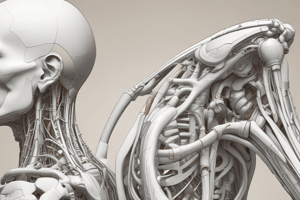Podcast
Questions and Answers
What is abduction?
What is abduction?
- Moving a body part toward the midline of the body
- Bending a body part backward
- Turning outward at the ankle
- Moving a body part away from the midline of the body (correct)
What does adduction mean?
What does adduction mean?
- Moving a body part towards the midline of the body (correct)
- Turning inward, such as at the ankle
- Bending a body part backward
- Moving a body part away from the midline of the body
What is circumduction?
What is circumduction?
- Turning outward at the ankle
- Straightening a flexed limb
- Moving a body part in a circular motion (correct)
- Bending a flexed limb
What does dorsiflexion refer to?
What does dorsiflexion refer to?
What is eversion?
What is eversion?
What does extension mean?
What does extension mean?
What is flexion?
What is flexion?
What does inversion mean?
What does inversion mean?
What is pronation?
What is pronation?
What does protraction refer to?
What does protraction refer to?
What is retraction?
What is retraction?
What does rotation mean?
What does rotation mean?
What is supination?
What is supination?
Flashcards are hidden until you start studying
Study Notes
Joint Movements Overview
- Abduction involves moving a body part away from the body's midline.
- Adduction refers to moving a body part closer to the midline of the body.
- Circumduction is the circular motion of a body part, such as an arm swinging.
Specific Joint Movements
- Dorsiflexion is the backward bending of a body part, exemplified by pulling the ankle towards the shin.
- Eversion is the outward turning movement at the ankle.
- Extension describes straightening a bent limb or spine.
Flexion and Other Movements
- Flexion is the act of bending a limb or the spine.
- Inversion is the inward turning movement, particularly at the ankle.
- Pronation involves rotating the hand so that the palm faces downward.
Forward and Backward Movements
- Protraction is the forward movement of a body part, such as the jaw thrusting forward.
- Retraction is the backward movement of a body part, like pulling the jaw backward.
Rotational Movements
- Rotation is the motion of a body part around its central axis.
- Supination is the action of turning the palm upwards.
Studying That Suits You
Use AI to generate personalized quizzes and flashcards to suit your learning preferences.




